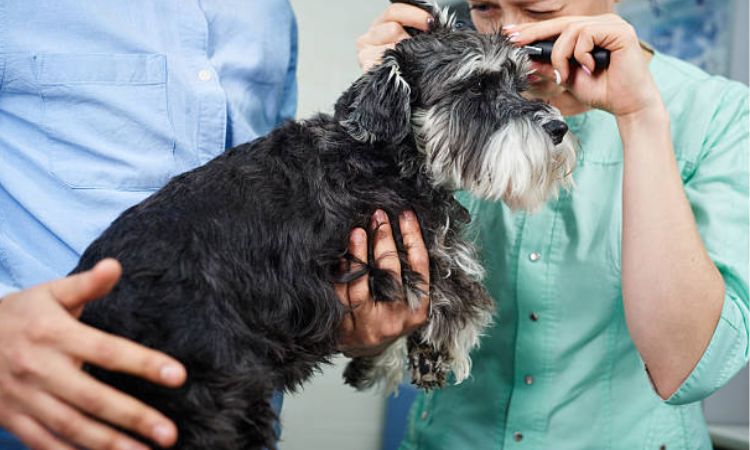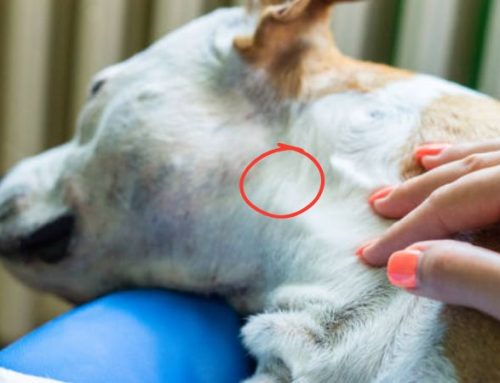If your dog’s ears smell bad, and you notice frequent head shaking or scratching, it could be a sign of an ear problem. Smelly ears often indicate infections, yeast overgrowth, or ear mites conditions that can cause discomfort and, if untreated, lead to more serious issues like hearing loss or balance problems.
Recognizing the signs early and addressing them promptly is key. In this guide, we’ll cover the main causes of smelly ears, why dogs shake their heads, and the most effective ways to treat and prevent ear problems, keeping your dog comfortable and healthy.
Main Causes of Smelly Ears and Head Shaking in Dogs
Dogs frequently develop ear problems that lead to unpleasant odors and behaviors such as head shaking, scratching, or tilting. Understanding the root causes is essential for effective treatment and prevention. Below are the main factors that contribute to smelly ears and head shaking in dogs:

1. Ear Infections (Yeast and Bacteria)
Ear infections, medically known as otitis externa, are among the most common causes of smelly ears in dogs. They can be caused by yeast overgrowth, bacteria, or a combination of both, and are often secondary to an underlying problem such as allergies or excessive moisture in the ears.
How they develop:
- Yeast and bacteria naturally exist in small amounts in healthy ears, but they can multiply rapidly if the ear environment becomes warm, moist, or irritated.
- Excessive wax, dirt, or debris can trap moisture, creating an ideal environment for microbial growth.
- Chronic scratching or previous infections can damage the ear canal, making it more susceptible to repeat infections.
Typical symptoms:
- Foul or musty odor (yeast often produces a sweet “Frito® chip” smell).
- Brown, yellow, or reddish discharge.
- Redness, swelling, or inflammation in the ear canal.
- Pain, sensitivity to touch, or discomfort.
- Frequent scratching, pawing at the ear, or shaking the head.
In severe or untreated cases, ear infections can progress to the middle (otitis media) or inner ear (otitis interna), potentially causing balance issues, circling, or even hearing loss.
2. Ear Mites and Other Parasites
Ear mites (Otodectes cynotis) are tiny parasites that can infest dogs’ ears, particularly puppies and dogs that spend time outdoors or live with other pets.
When they are more likely:
- Young dogs or kittens, especially in multi-pet households.
- Dogs with frequent outdoor exposure.
Signs of infestation:
- Dark, crusty, coffee-ground-like discharge inside the ear canal.
- Intense scratching or shaking of the head.
- Irritated, red, or inflamed ears.
- Sometimes secondary bacterial or yeast infections develop due to skin damage caused by mites.
Treatment requires veterinary intervention, often involving topical antiparasitic medications that target mites, eggs, and immature stages.
3. Allergies (Food or Environmental)
Chronic allergies are a major factor in recurring ear problems. Dogs may develop food allergies or environmental allergies (pollen, dust mites, mold) that trigger inflammation in the ears.
How allergies cause ear problems:
- Allergies often cause itchy, inflamed skin, which extends to the ear canal.
- Scratching, rubbing, and secondary infections can develop from the irritation.
- Recurrent ear inflammation can make ears more prone to yeast and bacterial overgrowth.
Symptoms associated with allergies:
- Recurrent or chronic ear infections.
- Red, swollen, or itchy ears.
- Excessive wax or discharge.
- Sometimes other skin symptoms, such as rashes or hot spots.
Addressing the underlying allergy through dietary changes, antihistamines, or immunotherapy helps prevent long-term ear issues.
4. Foreign Bodies and Water in the Ears
Foreign objects, such as grass seeds, dirt, or small debris, can lodge in a dog’s ear canal, causing irritation, inflammation, and odor. Moisture trapped in the ear after swimming, bathing, or rainy weather can also create an environment for bacterial or yeast growth.
Signs to watch for:
- Sudden onset of scratching, head shaking, or discomfort.
- Odor or discharge appearing shortly after outdoor activity or swimming.
- Visible debris if you inspect the outer ear.
Prompt veterinary attention is required to remove foreign bodies safely and prevent secondary infections.
5. Structural Factors
Certain anatomical characteristics make some dogs more prone to ear problems, smelly ears, and head shaking:
- Floppy ears (e.g., Cocker Spaniels, Basset Hounds): Floppy ears limit airflow, trapping moisture and creating a breeding ground for yeast and bacteria.
- Narrow ear canals: Some breeds have small or deep ear canals that trap wax and debris, reducing natural self-cleaning.
- Excess hair inside the ear canal: Hair can hold moisture and debris, leading to odor and infection.
- Excess wax production: Some dogs naturally produce more ear wax, increasing the risk of buildup and microbial overgrowth.
Dogs with these structural factors often require more frequent ear inspections, grooming, and routine cleaning to prevent infections.
Safe Home Care Before You See the Vet
Gentle Cleaning of the Outer Ear
- Focus only on the outer ear: Use a soft cloth, gauze, or a cotton ball dampened with a vet-approved ear cleaning solution. Gently wipe away visible dirt, wax, or discharge from the ear flap and the entrance of the ear canal.
- Avoid inserting anything deep into the ear canal: The ear canal has an “L” shape, and inserting cotton swabs or fingers can push debris further in, potentially injuring the eardrum.
- Limit to visible debris: Only remove what can be seen and easily reached. Stop if your dog shows signs of pain, discomfort, or resistance.

Products and Methods to Avoid
Some common home remedies or cleaning methods are unsafe for dog ears:
- Cotton swabs or Q-tips inside the ear canal: Can push wax, bacteria, or parasites deeper and may rupture the eardrum.
- Harsh home mixtures: Undiluted vinegar, hydrogen peroxide, alcohol, or essential oils can irritate sensitive ear tissue, worsen inflammation, or burn the canal.
- Excessive force or over-cleaning: Aggressive wiping or frequent cleaning can damage the skin, trigger pain, and increase the risk of infection.
Why these are risky: Dog ears are delicate, and many ear infections involve inflammation or microscopic tears. Using unsafe products or methods can worsen the infection, cause lasting damage, or interfere with veterinary diagnosis and treatment.
Keeping the Ear Dry and Your Dog Comfortable
- Prevent moisture buildup: After baths or outdoor activities, gently dry the outer ear. Avoid forcing air or inserting towels deeply into the canal. Moisture encourages yeast and bacterial growth.
- Reduce irritation: Keep your dog from scratching or pawing the ear. Using a soft e-collar or monitoring playtime may help prevent further injury.
- Comfort measures: Provide a calm environment, soft bedding, and gentle petting to reduce stress and discomfort. Avoid using home remedies that cause burning or stinging.
Veterinary Treatments for Dog Ear Problems
When at-home care is not enough or when an ear problem is severe, a veterinarian will prescribe professional treatments tailored to the underlying cause. Proper diagnosis is essential because dog ear issues whether bacterial, yeast, or caused by foreign bodies or allergies require specific care to avoid complications like chronic infections, hearing loss, or eardrum damage.
Prescription Ear Drops
- Antibiotic ear drops: Used to treat bacterial infections in the ear canal. They work by killing or inhibiting the growth of bacteria that cause inflammation, odor, and discharge.
- Antifungal ear drops: Designed to target yeast overgrowth, which often causes a sweet or musty odor and brown discharge. These medications help restore normal microbial balance in the ear.
- Anti-inflammatory ear drops: Corticosteroid or non-steroidal anti-inflammatory drops reduce swelling, redness, and pain, helping your dog feel more comfortable and allowing other medications to work effectively.
- Treatment duration: Typically, ear drop therapy lasts from 7 to 21 days, depending on the severity of the infection and the dog’s response. Consistency is crucial—stopping early can lead to reinfection.
Important: A veterinarian will determine the exact medication, dosage, and frequency based on a culture, cytology, or examination of the ear canal.
Oral Medications
- Pain relievers: For dogs showing discomfort, pawing at the ear, or head shaking, vets may prescribe pain management medications such as non-steroidal anti-inflammatory drugs (NSAIDs).
- Oral antibiotics: In severe or deep infections, oral antibiotics are sometimes necessary in addition to ear drops to fully resolve bacterial infections.
- Allergy medications: Dogs with chronic ear problems triggered by food or environmental allergies may receive oral antihistamines, corticosteroids, or immune-modulating drugs. These medications help reduce inflammation and prevent repeated infections.
Oral medications are usually used in conjunction with topical treatments and are carefully dosed to avoid side effects.
Professional Ear Flush and Deep Cleaning
- When it’s used: Deep cleaning is recommended for dogs with severe infections, excessive wax or debris, chronic otitis, or foreign bodies.
- Procedure: Under sedation or anesthesia, the veterinarian carefully removes all debris, discharge, and accumulated wax. This ensures that prescribed medications can reach the deeper parts of the ear canal and that the eardrum can be properly examined.
- Benefits: Reduces pain, prevents reinfection, and allows precise treatment planning. In some cases, follow-up flushes may be recommended.
Surgical Options for Chronic or End-Stage Ear Disease
- Indications: For dogs with chronic, recurrent ear infections that do not respond to medical therapy, or cases with severe structural damage (thickened canal, scarring, persistent inflammation), surgery may be necessary.
- Common procedures:
- Total ear canal ablation (TECA): Removal of the diseased ear canal to eliminate chronic infection and pain.
- Lateral bulla osteotomy (LBO): Sometimes performed alongside TECA to address middle ear disease.
- Outcome: Surgery is usually effective in resolving pain and infection, but it is considered a last resort due to its complexity and recovery requirements.
Veterinary treatment for dog ear problems is comprehensive and tailored to the cause and severity of the condition. Topical ear drops, oral medications, professional cleaning, and, in severe chronic cases, surgery work together to resolve infection, alleviate pain, and prevent recurrence. Timely veterinary intervention ensures the best outcomes, protects hearing, and improves your dog’s overall comfort and quality of life.

Preventing Smelly Ears and Head Shaking in Dogs
Keeping your dog’s ears healthy is the best way to prevent odor, discomfort, and head shaking. Proactive care involves routine checks, proper cleaning, managing environmental and medical factors, and seeking veterinary guidance when necessary.
1. Routine Ear Checks and Cleaning
Regular ear inspections allow you to detect problems before they become serious. How often you check and clean your dog’s ears depends on their breed, lifestyle, and medical history:
- Breed considerations: Dogs with floppy ears (Cocker Spaniels, Basset Hounds, Beagles) or narrow ear canals are more prone to infections and may require more frequent checks.
- Lifestyle factors: Dogs that swim often, bathe frequently, or play in dirt may need ear inspections after each activity.
- Medical history: Dogs with a history of ear infections or chronic allergies should have a tailored ear cleaning schedule, typically every 1–2 weeks, using a veterinarian-approved ear cleaner.
Always clean only the outer ear and avoid cotton swabs inside the ear canal to prevent pushing debris further in or damaging the eardrum.
2. Drying and Grooming
Moisture in the ears is a common trigger for infections and odor. To prevent this:
- Dry after baths or swimming: Use a clean towel or a vet-approved ear-drying solution to remove water. Avoid forcing liquids deep into the ear canal.
- Manage hair around the ear canal: Excessive hair can trap debris, wax, and moisture. For some breeds, trimming hair in and around the ear canal under the guidance of a veterinarian or groomer can reduce odor and infection risk.
3. Managing Underlying Causes
Preventing smelly ears also involves addressing the root causes that make infections more likely:
- Allergies: Food sensitivities or environmental allergens can trigger chronic ear inflammation. Maintaining prescribed allergy diets, medications, or injections helps reduce flare-ups.
- Diet: A balanced diet rich in omega fatty acids supports healthy skin and ear tissue, making infections less likely.
- Parasite control: Regular treatment for ear mites and other parasites is essential, especially in puppies or dogs exposed to other animals.
4. Scheduling Regular Rechecks
Dogs with a history of ear infections or chronic issues should have regular veterinary rechecks to catch recurring problems early. Your veterinarian may recommend:
- Follow-up exams every 3–6 months for dogs prone to infections.
- Periodic ear cytology to monitor yeast or bacterial growth even when the ears appear normal.
- Customized cleaning and medication plans to prevent reinfection.
Preventing smelly ears and head shaking is a combination of proactive care, environmental management, and addressing underlying health issues. Regular inspections, careful cleaning, keeping ears dry, managing hair, controlling allergies, maintaining a healthy diet, and preventing parasites all work together to keep your dog’s ears odor-free and comfortable. For dogs with chronic or recurrent ear problems, routine veterinary follow-ups are essential to maintain long-term ear health.
Dog owners might be interested






